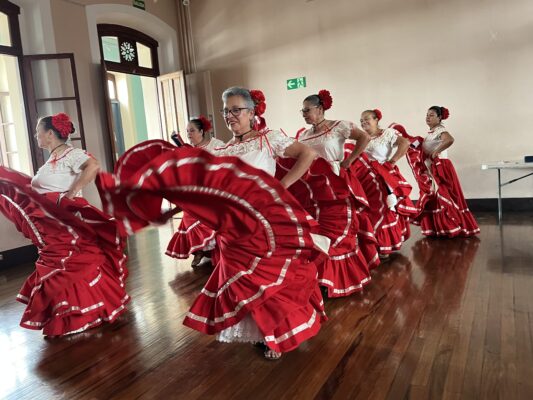
“Sana sana, cola de rana” is a Spanish saying which translates literally to “heal heal, frog’s tail” in English. According to Detroit first-year and native Spanish speaker Gladis Bazan-Vazquez, it’s just one example of Spanish phrases that “just don’t hit right in English.”
“It just sounds really comforting in Spanish,” Basan-Vazquez said. “It’s kinda like when you get a boo-boo and kiss it.”
In 2023, 287,431 households in Michigan spoke Spanish as their primary language at home, according to Data USA. At Albion College, Spanish is the only language with majors and minors available; there are currently a total 61 students taking Spanish classes.
Building an Accessible Community
For Spanish professor and department chair of modern languages and cultures Kalen Oswald, the benefits of learning Spanish start with the practical aspect of being understood and understanding others without relying on an intermediary.
“There are a lot of people in the United States whose first language is not English, and for most of those people, it’s Spanish,” Oswald said. “It just seems like a no-brainer that we should be trying to connect with these people instead of alienate them.”
Spanish lecturer Marcie Noble added that this need for connection includes emergency and medical situations. Though she said there is a “bare minimum” of accessibility for Spanish speakers at a governmental level, Noble has observed “a lack of accommodation in the vast majority of situations.”
This summer, while driving a friend to the emergency room, Noble said she discovered a Spanish speaker outside the building, struggling to access the resources to reach a family member inside.
“It was a really complicated and specific situation,” Noble said.
Most often, though many states have laws requiring some kind of interpreting services, Noble said children of Spanish speakers or staff untrained in interpretation end up stepping in. According to Noble, the reason for this is a lack of funding.
“If society isn’t going to come together and say ‘we think this is important,’ then I don’t think we’re going to see a lot of changes to that situation in the near future,” Noble said.
Knox, Indiana, first-year and Spanish minor Jeremy J. Mitchell said he is minoring in Spanish with the intention of practicing medicine accessible to Spanish speakers.
“It would be a giant problem if a patient and a provider couldn’t talk to each other,” Mitchell said.
In education itself, there are opportunities for greater accessibility for Spanish speakers. According to Mitchell, a student in one of his music classes uses an online tool to translate his handouts to Spanish.
Bazan-Vazquez, who went to a high school with a largely Hispanic population, said handouts were given in both Spanish and English. Bazan-Vazquez added that she wasn’t aware of any resources like that available at Albion College, though she’s content to receive her materials in English since she mostly speaks Spanish at home.
“Awareness could be better,” Bazan-Vazquez said.

The Beauty of Spanish
For Mitchell, Spanish is simply a “better language than English.”
Not only did Mitchell note that Spanish is the second-fastest language according to a 2011 study, but he said he enjoys its “particularity” for writing.
For Mitchell, there is efficiency in the language’s gendered terms, multitude of adjectives agreeing with the noun they describe and the wealth of commonly used tenses.
“In Spanish you have the subjunctive, which in English is rarely used and going out of style,” Mitchell said. “An example in English might be ‘would that I were,’ in Spanish it’s regularly used.”
In addition to being easy to spell and sounding “cool,” Oswald said the subjunctive mood is one of his favorite aspects of Spanish as a language.
“It makes these little subtle differences in what you’re expressing more precise and more interesting,” Oswald said.
Oswald said he started learning Spanish from his father, who was a Spanish teacher. He went on to study it in high school and college, as well as travel to several Spanish-speaking countries. Ultimately, it was a love for Mexican culture and a desire to connect with that culture through language that drew Oswald to Spanish.
“I realized the incredible cultural diversity in the Spanish-speaking world,” Oswald said. “It’s just fascinating and fun to see these different ways of seeing and experiencing the world.”
Cultural competence was an attractive part of learning Spanish for Noble, too.
“Apart from the beauty of the language itself, it’s also the access that it gave me to learning about other communities,” Noble said.
Inspiring Empathy, Delaying Disease
Noble said being multilingual gives learners access to a “level of empathy that they might not be able to attain without that additional skill.”
According to Oswald, this skill is more than just an exercise in social interaction, but in inner experience.
“It provides a way to have a deeper connection with people than you otherwise could,” Oswald said. “Learning a language necessitates a sort of perspective shift, a paradigm shift in your brain.”
Learning a language improves academic performance, memory, concentration, creativity and communication skills, states Cambridge University Press & Assessment.
“It can also help you live longer, and it can delay things like Alzheimer’s,” Oswald said. “It exercises your brain in such a way that is healthy physiologically.”
The MIT Press confirms this assessment, citing multiple studies wherein bilingual subjects developed dementia around four years later than monolingual patients.
Among these benefits – physical, mental, social, practical and cultural – Oswald and Noble both said they support a greater emphasis on language learning in the U.S.
“It helps the individual, and it helps the world,” Oswald said. “If more people learn a language, they gain an understanding of themselves and others through that perspective.”

Leave a Reply